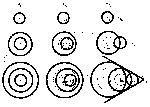
Figure 1a: Shock Waves
Click on Thumbnail to see Full-size image.
When the actual wind and temperature variations that occur in the
atmosphere are taken into account, the simple conical pattern of the
shock front may become quite distorted. The sound speed generally
decreases with altitude between the ground and the plane. Therefore,
as a propagating shock wave descends toward the ground, the portion
of the wave front closest to the earth moves faster than the portions
above. If the sound speed decreases sufficiently rapidly with
altitude, the wave front may become perpendicular to the ground. In
this situation the shock never reaches the ground because it begins
to travel parallel to the ground before it gets there (Carlson,
1966). Physical requirements for such an effect, however, are
unlikely, even under extremely abnormal atmospheric conditions. In
any event, an object moving through the atmosphere at any altitude
parallel to. the earth's surface, at a speed greater than the speed
of sound at ground level would inevitably produce a sonic boom.
The decrease of sound speed with altitude also affects the portion of
the wave front that spreads out to the sides of the plane. An
investigation of the effect by Kane (1966), under conditions of no
wind, shows that the lateral extent of the sonic boom at ground level
ranges from about 10 to 35 miles on either side of the ground track
of the plane. Furthermore, the intensity of the shock wave will be
diminished as it spreads out. Consequently the boom will become less
intense on either side of the flight track.
When wind is present, the wave front progresses at a rate which is
the sum of the sound speed and the wind speed. Therefore the effect
on the wave front by the temperature decrease is counteracted if a
tail wind increases with altitude. If a tail wind decreases with
altitude the distortion of the wave front caused by the temperature
variation is reinforced, while a head wind produces the opposite
effect. The situation becomes more complicated when the horizontal
variations of wind and temperature are considered.
Although various government agencies, industrial organizations and
university research projects are currently engaged in seeking methods
to reduce sonic boom intensities, all known practical supersonic
airplane designs will produce sonic booms (National
Academy of Sciences, 1967). Furthermore, according to the Academy
report, "The possibility that unconventional configurations may be
devised which will yield significant reductions cannot be disallowed
but, at present, the future must be viewed in terms of small
reductions obtained through better understanding of theory, design
refinements of conventional aircraft and improvements in propulsive
efficiency and operating procedures." Research efforts are continuing
in an effort to find an unconventional design, with practical
aerodynamic. characteristics, which would minimize or eliminate the
sonic boom.
The various research efforts to suppress sonic boom intensities which
are under investigation are reviewed below.
The pressure distribution at ground level, shown in Fig. la and lb is
the so-called "farfield" signature. The shock fronts emanating from
protuberances on the aircraft have little effect on the pressure
pulse at ground level. The sonic boom can be reduced, but not
necessarily eliminated, if the aircraft climbs at subsonic speeds
before making the transition to supersonic speeds at high-altitude
cruising levels. Optimization of the arrangement of the various
components, such as the shape and position of the wings, may lessen
sonic boom intensity. Long, slender and blended configurations appear
to offer
Aircraft accelerations and maneuvers at various altitudes cause sonic
booms of varying intensities in localize regions at or above ground
level. It is possible, during common flight maneuvers, to produce
local pressure buildups which may be more than twice as large as
those produced by the same aircraft in level, unaccelerated flight.
The subsequent "superbooms" occur at isolated points at ground level
in contrast to the ordinary booms that move with the aircraft.
Limitations on rapid accelerations and maneuvers would reduce the
intensity and frequency of "superbooms" but could not be expected to
suppress sonic booms altogether (Maglieri, 1966).
In subsonic flight, pressure disturbances propagate ahead of the
aircraft altering the airstream in such a way that abrupt pressure
changes do not occur. In supersonic flight however, pressure
disturbances cannot propagate ahead. In order to prevent the buildup
of a shock wave in supersonic flight, the Northrup Corporation is
currently working on a method to modify the airstream through an
electromagnetic force field concentrated at the nose of the aircraft.
This work is still in preliminary stages and experiments have only
been undertaken in wind tunnels (Aviation Week and Space Technology,
1968).
Although sonic boom research has progressed rapidly since the early
1950's, the complete suppression of sonic booms at ground level by
means of present technology does not appear imminent. This does
Aviation Week and Space Technology, 88 (1968), p. 21.
Carlson, H.W. and F.E. McLean. "The sonic boom", Int. Sci.
Tech, No. 55 (1966), p. 70.
Hall, R.H., (ed.). The UFO Evidence. National
Investigations Committee on Aerial Phenomena, Washington, D.C.: 1964.
Kane, E.J. "Some effects of the nonuniform atmosphere on the
propagation of sonic booms", J. Acoust. Soc. Amer., 39 (1966),
S26-S30.
Maglieri, D.J. "Some effects of airplane operations and the
atmosphere on sonic-boom signatures", J. Acoust. Soc. Amer.,
39 (1966), S36-S42.
McLean, F.E. and B.L. Shrout. "Design methods for minimization of
sonic boom pressure-field disturbances", J. Acoust. Soc.
Amer., 39 (1966), S19-S25.
National Academy of Sciences. Report on Generation and Propagation
of Sonic Boom. 1967.
Roberts, C., W. Johnson, G. Herbert, and W.A. Hass.
Meteorological Investigations in Sonic Boom Experiments at Edwards
AFB. National Sonic Boom Evaluation Office, Arlington, Virginia,
Dl-Dll, (1967).
Wilson, H.A., Jr. "Sonic boom", Sci. Amer. 206 (1962), 36-43.

Figure 1b: Sonic Boom
Click on Thumbnail to see Full-size image.
3. Atmospheric Effects on Sonic Boom Propagation
4. Design Modifications and Maneuvers
5. Comments
Acknowledgement
References